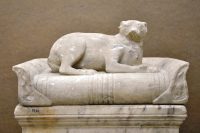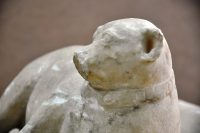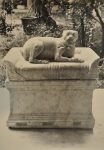 The National Archaeological Museum in Athens has pulled a once-beloved dog from storage and put it on display for the first time since it was discovered 81 years ago. The small sarcophagus adorned with a sculpture of a pet dog dates to the mid-3rd century A.D., the Roman period. It was unearthed in 1937 on the north side of the National Garden in downtown Athens. The ancient Greek road from Athens to Mesogeia, the interior region of the Attic peninsula, ran along what is now Vasilissis Sophias Ave, the north border of the National Garden. As we know, Romans often used the road out of town was for burials, and while no other wee dog sarcophgi have been found in this area, excavations done during construction of the subway station at Syntagma Square just a couple of blocks away did reveal other Roman-era animal graves.
The National Archaeological Museum in Athens has pulled a once-beloved dog from storage and put it on display for the first time since it was discovered 81 years ago. The small sarcophagus adorned with a sculpture of a pet dog dates to the mid-3rd century A.D., the Roman period. It was unearthed in 1937 on the north side of the National Garden in downtown Athens. The ancient Greek road from Athens to Mesogeia, the interior region of the Attic peninsula, ran along what is now Vasilissis Sophias Ave, the north border of the National Garden. As we know, Romans often used the road out of town was for burials, and while no other wee dog sarcophgi have been found in this area, excavations done during construction of the subway station at Syntagma Square just a couple of blocks away did reveal other Roman-era animal graves.
 The dog sits on the lid of the sarcophagus, his front legs crossed in a dignified posture, comfortably ensconced on his plush striped bed. His collar is studded with gemstones — circles, squares and diamond-shaped — and a bell hangs from a loop in the front. The collar, bedding and bell unmistakably identify the dog as somebody’s cherished pet rather than a symbolic representation of a deity or a funerary sacrifice.
The dog sits on the lid of the sarcophagus, his front legs crossed in a dignified posture, comfortably ensconced on his plush striped bed. His collar is studded with gemstones — circles, squares and diamond-shaped — and a bell hangs from a loop in the front. The collar, bedding and bell unmistakably identify the dog as somebody’s cherished pet rather than a symbolic representation of a deity or a funerary sacrifice.
Funerary monuments to dearly departed dogs are unusual but not unheard of in the Roman archaeological record. Most of them are stele engraved with just an inscription and sometimes a low relief of the animal and an inscription clearly identifying them as grave markers for the pet. The British Museum has a wonderfully expressive example of a marble epitaph plaque inscribed with a poem written from the perspective of the dog who was buried under it.
Gaul gave me my birth and the pearl-oyster from the seas full of treasure my name, an honour fitting to my beauty.
I was trained to run boldly through strange forests
and to hunt out furry wild beasts in the hills
never accustomed to be held by heavy chains
nor endure cruel beatings on my snow-white body.
I used to lie on the soft lap of my master and mistress
and knew to go to bed when tired on my spread mattress
and I did not speak more than allowed as a dog, given a silent mouth
No-one was scared by my barking
but now I have been overcome by death from an ill-fated birth
and earth has covered me beneath this small piece of marble.
Margarita [“Pearl”]
 Animal figures have also been found on the funerary reliefs of children, see for example this sweet memorial to “To Helena, foster daughter, the incomparable and worthy soul,” at the Getty.
Animal figures have also been found on the funerary reliefs of children, see for example this sweet memorial to “To Helena, foster daughter, the incomparable and worthy soul,” at the Getty.
Complete three-dimensional sculptures of dogs on sarcophagi are a horse of a different color. They are so rare that only one other example has been found on the Attic peninsula. It too is in the collection of the National Archaeological Museum, but it’s still in storage.
 The marble pooch was rescued from the pound on Monday and will be on display through October 21st only.
The marble pooch was rescued from the pound on Monday and will be on display through October 21st only.
A selection of artifacts from the museums store rooms have been placed on display for the Unseen Museum exhibition, each for a period of two months. The particular artifact complements the temporary exhibition “Hadrian and Athens: Conversing with an Ideal World” that opened on November 27 and will run for a year.
In August and until October, museum archaeologists will conduct tours for visitors that focus on the habits of ancient Athenians, including their strong ties to pet animals. These will be held on three Sundays (August 19, September 16 and October 21) and two Fridays (September 14 and October 19), starting at 13:00. To attend the presentations, visitors must first obtain a ticket on arrival.